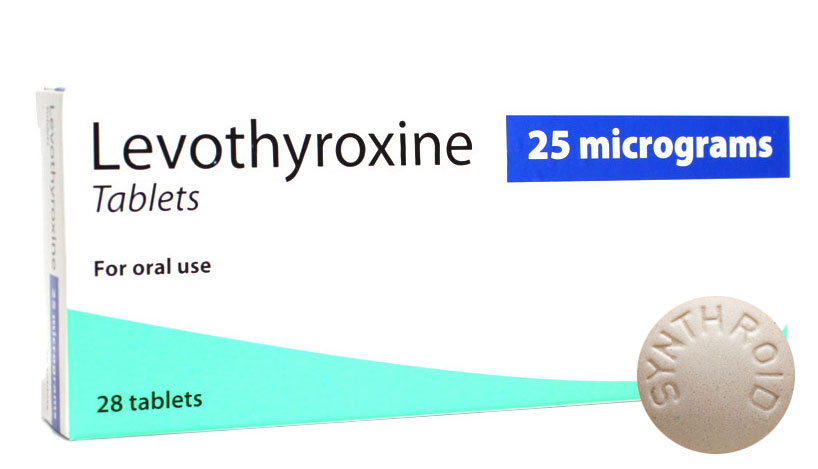Levothyroxine is a thyroid medicine that replaces a hormone normally produced by your thyroid gland to regulate the body's energy and metabolism. Levothyroxine is used to treat hypothyroidism (low thyroid hormone). This medicine is given when your thyroid does not produce enough of this hormone on its own. is a drug with a narrow therapeutic index, applied in small amounts (micrograms), which makes interactions in the absorption phase clinically significant. The main aim of this article was to review and present the latest information on factors that affect the gastrointestinal absorption of this drug. Levothyroxine is also used to treat or prevent goiter (enlarged thyroid gland), which can be caused by hormone imbalances, radiation treatment, surgery, or cancer.
Brand Names: Euthyrox, Levoxyl, Synthroid, Tirosint, Tirosint-Sol, Unithroid
Levothyroxine was the third-most commonly prescribed medication in the United States in 2017, with more than 101 million prescriptions.
Drug Fact
Class : Thyroid hormone
Category: Prescription Only
Uses: treat or prevent goiter (enlarged thyroid gland), which can be caused by hormone imbalances, radiation treatment, surgery, or cancer.
Consumed by: adults and children
Pregnancy category: A
Category A: Controlled studies in women fail to demonstrate a risk to the fetus in the 1st trimester (and there is no evidence of a risk in later trimesters), and the possibility of fetal harm remains remote.
Dosage form: tablet, injection
Administration
Should be taken on an empty stomach. Take 30 min-1 hr before meals.
Contraindications
Untreated hyperthyroidism; uncorrected adrenal insufficiency; acute MI.
Special Precautions
Patients w/ CV disease (e.g. angina, heart failure, HTN), DM and diabetes insipidus, epilepsy, pre-existing myasthenia syndrome, long-standing hypothyroidism. Elderly, pregnancy and lactation.
Adverse Reactions
Nervousness, excitability, tremor, muscle weakness, fatigue, cramps; sweating, flushing, heat intolerance, headache, fever, insomnia, tachycardia, palpitations, restlessness, anginal pain, HTN, severe depression, difficulty in sleeping, excessive wt loss; menstrual irregularities; diarrhoea, vomiting, psychosis or agitation. Increased bone resorption and reduced bone mineral density, especially in post-menopausal women; elevated LFT.
Potentially Fatal: Thyrotoxic crisis including convulsions, cardiac arrhythmia, heart failure, coma.
Pregnancy Category (US FDA)
IM/IV/Parenteral/PO: A
Monitoring Parameters
Monitor thyroid function test, clinical signs of hypo- and hyperthyroidism, heart rate and BP.
Overdosage
Symptoms: Increased BP, fever, tachycardia, agitation, arrhythmias, anxiety states, hyperkinesis, confusion, neurological complications and coma. Management: Use of activated charcoal and a β-blocker (e.g. propranolol or metoprolol) for tachyarrhythmia. Symptomatic and supportive treatment must also be applied.
Drug Interactions
Reduced absorption w/ iron, antacids, bile acid sequestrants, colestyramine, simeticone, Ca carbonate, sucralfate, cation exchange resins. Reduced tri-iodothyronine serum levels w/ amiodarone and propranolol. Reduced serum levels w/ carbamazepine, phenytoin, phenobarbital, rifampicin, lithium, oestrogens, sertraline. Androgens may decrease levothyroxine-binding globulins serum levels. May alter requirements of antidiabetic drugs. Increased risk of significant HTN and tachycardia w/ ketamine. Increased metabolic demands w/ sympathomimetics (e.g. epinephrine). May increase anticoagulant effect of warfarin.
Food Interaction
Decreased bioavailability and lower serum levels w/ enteral nutrition. Reduced absorption w/ food, soybean infant formula, cottonseed meal, walnuts and dietary fibre.
Action
Description: Levothyroxine Na is a synthetic form of thyroxine which increases the basal metabolic rate (BMR) and the utilisation and mobilisation of glycogen stores and stimulates protein synthesis. It is also involved in normal metabolism, growth and development. These effects are mediated at the cellular level by the thyroxine metabolite, tri-iodothyronine.
Onset: Oral: 3-5 days; IV: 6-8 hr.
Pharmacokinetics:
Absorption: Variable but adequate from the GI tract. Food decreases absorption. Bioavailability: Oral: 64% (nonfasting state); 79-81% (fasting state). Time to peak plasma concentration: 2-4 hr.
Distribution: Crosses the placenta; minimal amount enters breast milk. Plasma protein binding: >99% (mainly to thyroxine-binding globulin; lesser extent to thyroxine-binding pre-albumin or to albumin).
Metabolism: Hepatic and renal metabolism. Converted to liothyronine and inactive reverse triiodothyronine which undergo further deiodination to inactive metabolites; conjugation also occurs; undergoes enterohepatic recirculation.
Excretion: Via urine (as a free drug, deiodinated metabolites or conjugates); faeces (approx 20%; as free hormone). Elimination half-life: Approx 6-7 days. Prolonged in hypothyroidism and reduced in hyperthyroidism.
Storage
Store between 15-30°C. Protect from light and moisture.


0 Comments